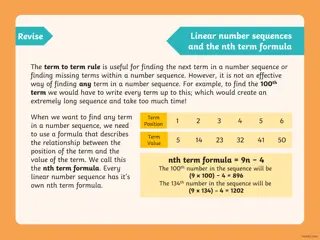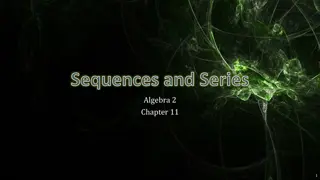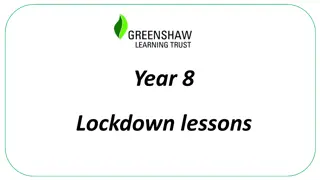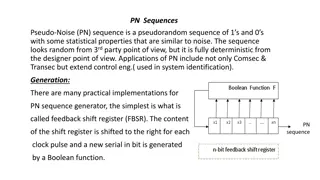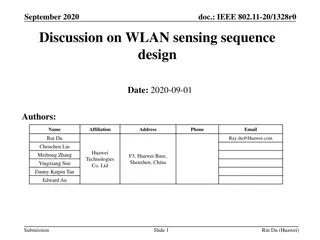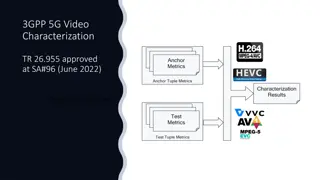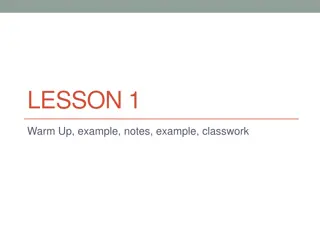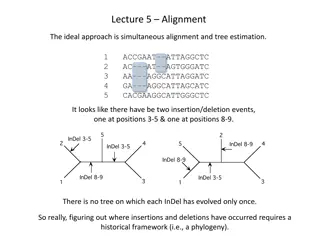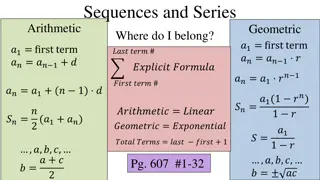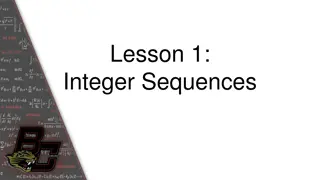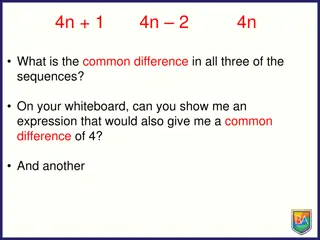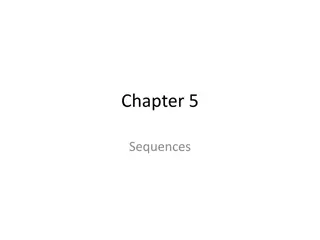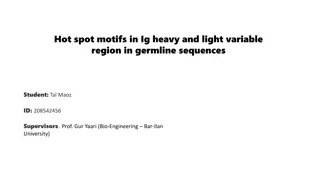Understanding Sequences and Series
Exploring the concepts of sequences and series in mathematics, including definitions, examples, and exercises on arithmetic sequences, geometric progressions, and general terms. Learn about generating sequences, finding nth terms, common differences, and common ratios in different types of sequences. Practice solving problems and understanding the relationships between terms in a sequence or progression.
Download Presentation

Please find below an Image/Link to download the presentation.
The content on the website is provided AS IS for your information and personal use only. It may not be sold, licensed, or shared on other websites without obtaining consent from the author. Download presentation by click this link. If you encounter any issues during the download, it is possible that the publisher has removed the file from their server.
E N D
Presentation Transcript
SEQUENCES AND SERIES
Introduction - Sequence A sequence or progression is an ordered set of numbers which can be generated from a rule. General sequence terms as denoted as follows a1 first term, a2 second term, , an nthterm etc The rule may give nthterm, an, as a function of n
Introduction Sequence (cont) Example: Given a infinite sequence 1 2, 2 3 ,3 4 ,4 5, The rule or general term ? ??= ? + 1 Example: Given a infinite sequence 1 2, 1 4 ,1 8 , the general term is 1 2? ??=
Exercises: i. Write down the first four term of the sequence with general term ??= 2? 1 1 ii. iii. What is the 100thterm of the sequence of What is the twenty-first term of the sequence? ??= 1?? + 1 ?
Arithmetic Sequence (Progression) -AP An arithmetic sequence or arithmetic progression is a sequence of numbers such that the difference of any two successive members of the sequence is a common constant. In general, an AP is written in the form of {a, a + d, a + 2d, a + 3d, a + (n 1)d, } where a is the first term and d is the common difference
Arithmetic Sequence (Progression) AP (cont) If the initial term of an AP is a1and the common difference of successive numbers is d, then the nth term of the sequence is given by: Example 1: Write down the nthterm of the arithmetic sequences a) -10, -5, 0, 5, b) ?, ? 2, 2,0,?
Arithmetic Sequence (Progression) AP (cont) Example 2: The 4thterm of an arithmetic sequence is 12 and the tenth term is 42. a) Given that the first term is u1and the common difference is d, write down two equations in u1 and d that satisfy this information. b) Solve the equations to find the values of u1and d.
Geometric Sequences (Progression) GP A geometric progression (GP) is a sequence of numbers in which each number is multiplied by the same factor to obtain the next number in the sequence. For example, the sequence 2, 6, 18, 54, is a GP with common ratio 3. Thus, the general form of a GP is ?,??,??2,??3, where a is the first term and r is the common ratio
Geometric Sequences (Progression) GP (cont) The nth term of a GP with initial value a and common ration r is given by = n a 1 n ar Note: the common ratio r should not be 0 or 1 If r is 0, then we have : a, 0, 0, 0, (not GP) If r is 1, then we have : a, a, a, a, (not GP) Example 3: Write down the first five terms of the GP which has first term 1 and common ration . Find the 10thand 20thterm of the sequence.
Geometric Sequences (Progression) GP (cont) Example 4: The 3rdterm of a GP is 3 and the 6th term is 3/8. Find the common ratio r and the first term a1.
Limit of infinite sequence The limit of a sequence is the value to which its term approach indefinitely as n becomes large. If the limit of a sequence anis L, we can write as lim ? ??= ? If a sequence has a (finite) limit, then it is said to be convergent. If a sequence becomes arbitrarily large (approaches ), then it is said to be divergent lim ? ??=
Limit of infinite sequence (cont) Example 5: a) b) lim ? 1 ? ? + 1 ? lim ? c) 1 lim ? ?2+ 1 d) ? ?2 lim
Series and Partial Sums When we sum up just n terms of a sequence, it is called the partial sums Sn. ??= ?1+ ?2+ ?3+ + ?? When we sum up an infinite sequence, it is called a series . ??= ?1+ ?2+ ?3+ + ??+
Arithmetic Series Given an arithmetic sequence ?,? + ?,? + 2?, ,? + ? 1 ?, Then, the arithmetic series can be written as ? = ? + ? + ? + ? + 2? + + ? + ? 1 ? + The sum of the first n terms of an arithmetic sequence is n Sn = + ( ) a l 2 where a1is the first term and l is an, the last term of a finite sequence. Or n a Sn ( 2 2 n = + ) 1 d
Arithmetic Series (cont) Example 6: a) Find the sum of the first 50 terms of the sequence {1, 3, 5, 7, 9, } b) Find the sum of the series 1+ 3.5 + 6 + 8.5 + + 101
Geometric Series Given a geometric sequence ?,??,??2, ,??? 1, Then, the geometric series can be written as ? = ? + ?? + ??2+ ??3+ + ??? 1+ The sum of the first n terms of an geometric sequence is 1 ( ) 1 n n ) ( a r a r = / S n 1 1 r r provided that r 1.
Geometric Series (cont) Example 7: a) Given the first two terms of a geometric progression as 2 and 4, what is the sum of the first 10 terms? b) Find the sum of the first 20 terms of the geometric series 2 + 6 + 18 + 54 +
Convergence /divergence series The nthpartial sum of an arithmetic series is ??=? 22? + ? 1 ? What will happen when n becomes very large (approaches )? That is ? 22? + ? 1 ? lim ? ??= lim ? The series approaches infinity. Thus, an arithmetic series is a divergence series for any a and d.
Convergence /divergence series (cont) The nthpartial sum of an geometric series is ??=?(1 ??) 1 ? What will happen when n becomes very large (approaches ) ? That is ?(1 ??) 1 ? lim ? ??= lim ? If|r|<1, then rn 0 as n , thus the series is converged i.e. Sn =1 a r If|r| > 1, then rn as n , thus the series is diverged
Convergence /divergence series (cont) Example 8: a) For the geometric progression whose first two terms are 5 and , find S . b) Consider a geometric progression whose first three terms are 12, -6, 3. Find both S8and S . c) For the geometric progression whose first two terms are 2 and 4, find S7, S20and S .





